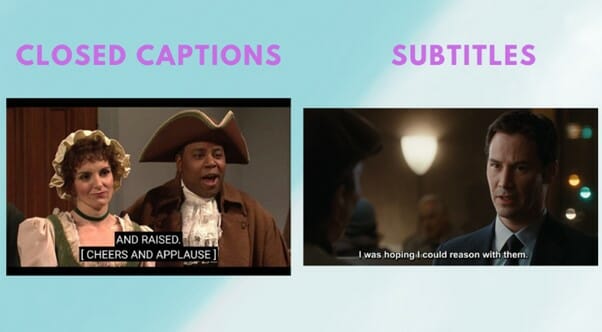Some people consider subtitles and captions interchangeable because they both provide a textual version of the audio in a video. However, there are key differences between them. Mixing these services can lead to issues, especially if you require a specific service like subtitles for a movie or a live event.
Here, we’ll explore the primary distinctions between them, elucidate the objectives each service aims to achieve, and highlight important details that set them apart from each other.

What are subtitles?
Subtitles are a form of captions used for translating audio dialogue from one language to another. In simpler terms, subtitles translate the language of the video into another. You’ll see subtitles used in many foreign films and programs.
On the other hand, Closed Captions (CC) are in the same language as the original audio.
What are captions?
Closed captions, also known as CC or subtitles for the deaf and hard of hearing (SDH), serve the purpose of enabling individuals who are deaf or hard of hearing to access video content. In addition to displaying dialogue, closed captions encompass background sounds and speaker identification, providing a comprehensive viewing experience for those with hearing impairments. Conversely, subtitles are designed with the assumption that the viewer can hear the audio and thus omit background sounds and speaker notifications. So, what’s closed caption mean? Closed captions ensure inclusivity by making audiovisual content accessible to a wider audience, particularly those who rely on text to understand spoken information.
Key Differences
Subtitles
- It is not assumed that viewers can hear the sound.
- Includes dialogue, sound effects, music, etc.
- Primarily intended for deaf or hard of hearing audiences.
- Often added after the release of the movie or show.
- Displays all dialogue and audio as text.
- Translates languages into text.
Captions
- Assumes viewers can hear the sound.
- Includes only dialogue.
- Intended for an audience that may not speak the original language.
- Developed prior to the release of the movie or show.
- Represents dialogue and audio as text.
Subtitles and captions serve different purposes: Subtitles enable people to watch videos, even if they don’t speak the language. With the rise of global video platforms, many content creators recognize the value of adding subtitles to make their content accessible in multiple languages.
The increase in subtitle usage coincides with the growth of mobile video consumption; more people watch videos in public places with the sound turned off.
Why use subtitles?
- Provides accessibility to potentially millions of deaf/hard of hearing viewers.
- Enhances viewer engagement.
- Improves user interface.
- Makes digital content more searchable on the internet.
- Access to the same content without sound.
How it works
Creating subtitles is a modern process involving skilled subtitlers, specialized computer programs, and speech recognition software. There are three main methods for creating captions:
- Re-speaking: For real-time captioning, the re-speaker listens to what is being said and then repeats the dialogue into a microphone connected to specialized computer software. This software recognizes the re-speaker’s voice and converts it into on-screen captions. Re-speaking is mainly used for live broadcasts.
- Stenography: Stenographers use stenotype machines to convert spoken words into text. A stenotype machine is a specially designed typewriter with a limited number of keys that produce stenography in English. This stenography is then translated into readable text using computer software. Stenography is used for live captioning.
- Typing: Caption authors use a standard keyboard to type captions from scratch into captioning software. They must also time each caption to synchronize with the audio track. This method is time-consuming and is typically used for pre-recorded content.
These methods ensure that videos are accessible to a wider audience, catering to both those who can hear and those who cannot.
Summary
In conclusion, subtitles and captions, although seemingly similar, serve different purposes and are intended for different audiences. Subtitles are primarily intended to translate sound from one language to another and are useful for multilingual viewers. In contrast, subtitles, also known as closed captioning (CC), are created to make content accessible to deaf and hard-of-hearing people, including background sounds and speaker identification.
Understanding the differences between these two services is critical, as mixing them can be confusing and make content difficult to understand. Whether you are a content creator, consumer, or distributor, knowing when and how to properly use subtitles or captions can greatly enhance the accessibility and inclusivity of your content. Subtitles and captions are playing an increasingly important role in ensuring that video content reaches a wider and more diverse audience.
Whether you’re enjoying a video in a noisy environment, learning a new language, or being part of the deaf and hard-of-hearing community, these services enhance the viewing experience and contribute to a more inclusive media environment. Therefore, when producing or consuming video content, it is important to choose the right service based on specific needs and goals so that ultimately everyone can enjoy and understand the audiovisual content presented.
